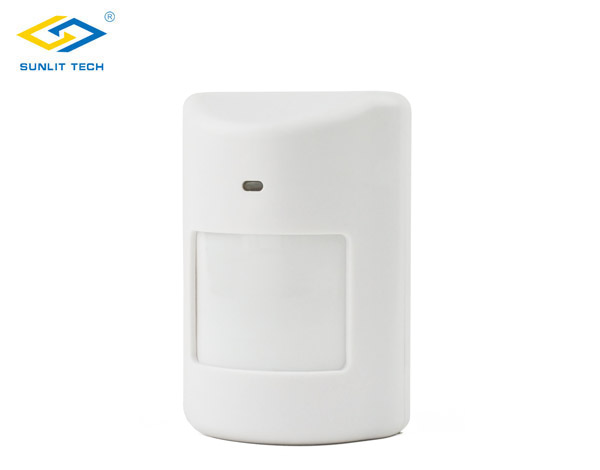What Are the Differences in Working Principles of Various Infrared Sensors?
Infrared is a kind of light that is invisible to the human eye, so it has all the characteristics of light. All substances above absolute zero, i.e. -273℃, can produce infrared. According to the characteristics of infrared, infrared is used in a variety of sensors, such as infrared temperature and humidity sensors, human infrared detectors, etc. Infrared sensors are also divided into different types according to the emission method and energy conversion method. Let's take a closer look at the working principles and characteristics of different infrared sensors.

According to the different emission methods, infrared sensors can be divided into active and passive types
1. Active infrared sensor The transmitter of the active infrared sensor emits a modulated infrared beam, which is received by the infrared receiver to form a warning line composed of infrared beams. When encountering leaves, rain, small animals, snow, dust, fog, there should be no alarm, and people or objects of considerable volume will cause an alarm. Active infrared detector technology mainly adopts one send and one receive, which belongs to linear prevention. Now it has developed from the initial single beam to multiple beams, and it can also send and receive double beams to minimize the false alarm rate, thereby enhancing the stability and reliability of the product. Since infrared rays are a detection medium with good incoherence to environmental factors (good incoherence to sounds, lightning, vibrations, various artificial light sources and electromagnetic interference sources in the environment); and also a product with good coherence to target factors (only targets that block the infrared beam will trigger an alarm), active infrared sensors will be further promoted and applied.
2. Passive infrared sensors Passive infrared sensors work by detecting infrared rays emitted by the human body. The sensor collects infrared radiation from the outside and then gathers it on the infrared sensor. Infrared sensors usually use pyroelectric elements, which release charges to the outside when the temperature of the infrared radiation changes, and generate alarms after detection and processing. This sensor is aimed at detecting human radiation. Therefore, the radiation-sensitive element must be very sensitive to infrared radiation with a wavelength of about 10μm. In order to be sensitive to the infrared radiation of the human body, its radiation surface is usually covered with a special filter to significantly control the interference of the environment. The passive infrared sensor contains two pyroelectric elements connected in series or in parallel. Moreover, the two polarization directions of the two electrodes are just opposite, and the background radiation of the environment has almost the same effect on the two pyroelectric elements, so that the pyroelectric effects they produce cancel each other out, so the detector has no signal output. Once the intruder enters the detection area, the infrared radiation of the human body is focused through the partial mirror and received by the pyroelectric element, but the heat received by the two pyroelectric elements is different, and the pyroelectricity is also different, which cannot be offset, and the alarm is triggered after signal processing. Passive infrared sensors are widely used in human infrared detectors.

According to the different energy conversion methods, infrared sensors can be divided into photon type and pyroelectric type
1. Photon infrared sensor Photon infrared sensor is a sensor that works by using the photon effect of infrared radiation. The so-called photon effect refers to when infrared rays are incident on certain semiconductor materials, the photon flow in the infrared radiation interacts with the electrons in the semiconductor material, changing the energy state of the electrons, thereby causing various electrical phenomena. By measuring the changes in the properties of electrons in semiconductor materials, the strength of the corresponding infrared radiation can be known. The main types of photon detectors are internal photodetectors, external photodetectors, free carrier detectors, QWIP quantum well detectors, etc. The main features of photon detectors are high sensitivity, fast response speed, and high response frequency, but the disadvantage is that the detection band is narrow and generally works at low temperatures (in order to maintain high sensitivity, liquid nitrogen or thermoelectric refrigeration is often used to cool the photon detector to a lower operating temperature).
2. Pyroelectric infrared sensor Pyroelectric infrared sensor uses the thermal effect of infrared radiation to cause the temperature change of the element itself to detect certain parameters. Its detection rate and response speed are not as good as photon sensors. However, since it can be used at room temperature and its sensitivity is independent of wavelength, it has a wide range of applications. Pyroelectric infrared sensors that use the pyroelectric effect of ferroelectrics have high sensitivity and have been widely used. Pyroelectric effect When certain insulating materials are heated, as the temperature rises, equal but opposite charges will be generated at both ends of the crystal. This electric polarization phenomenon caused by thermal changes is called the pyroelectric effect. The pyroelectric effect has been used in pyroelectric infrared sensors in the past decade. Crystals that can produce pyroelectric effects are called pyroelectrics, also known as thermoelectric elements. Common materials for thermoelectric elements include single crystal, piezoelectric ceramics and polymer films.

Structure of pyroelectric infrared sensor Pyroelectric infrared sensor consists of the following four main parts:
① Aluminum substrate and field effect transistor (FET) constituting the circuit;
② Ceramic material with pyroelectric effect;
③ Window material to limit the wavelength of incident infrared;
④ TO-5 type tube cap and tube socket of the shell. Since the detector element has the disadvantages of short detection distance and difficulty in processing the subsequent circuit of the obtained signal when used alone, infrared assemblies are currently used for detection. The infrared assembly consists of a pyroelectric infrared sensor, a lens, a measurement conversion circuit and a sealed tube shell. The lens can expand the detection range and improve the sensitivity of the measurement; the measurement conversion circuit can complete the signal processing process such as filtering and amplification; the sealed tube shell can prevent erroneous actions caused by external noise. This assembly is small in size, low in cost and diverse in functions, so it is widely used.
 简体中文
简体中文
